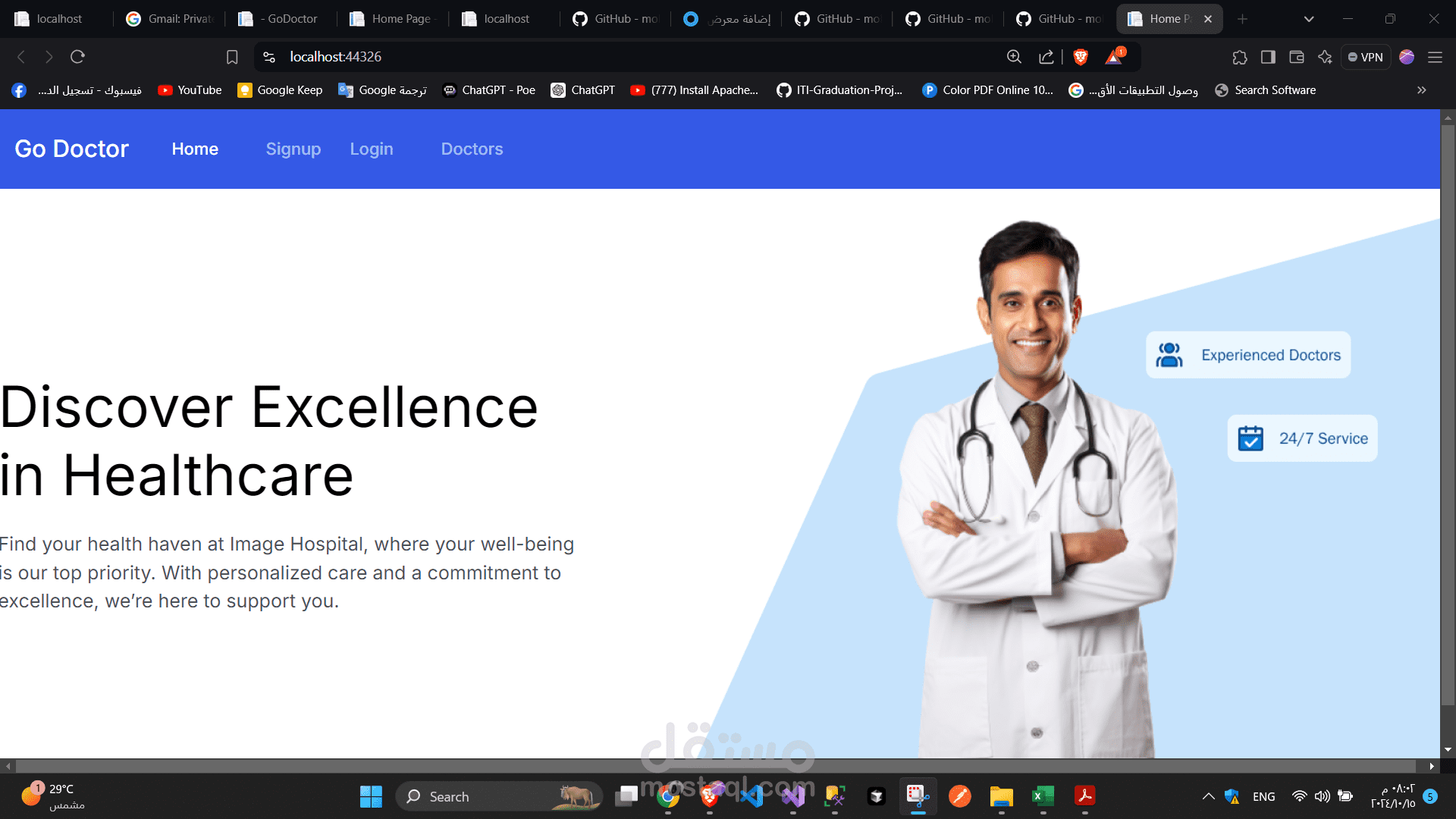DoctorGo
تفاصيل العمل
1. Development Frameworks and Tools
ASP.NET Core MVC: I used ASP.NET Core MVC for building the platform's backend and frontend. The Model-View-Controller (MVC) pattern helped to separate concerns, ensuring better maintainability and testability. I adhered to SOLID principles to make the system modular and easy to extend.
Bootstrap: For the user interface (UI), I leveraged Bootstrap to create responsive and visually appealing designs. The platform supports multiple screen sizes, ensuring a smooth experience on both mobile and desktop devices.
Entity Framework Core: Entity Framework Core was used for database management, enabling object-relational mapping (ORM) for smooth interaction between the C# objects and the SQL Server database. This streamlined database operations like CRUD actions (Create, Read, Update, Delete) for patients, doctors, appointments, and reviews.
2. User Authentication with ASP.NET Core Identity
Identity Integration: I integrated ASP.NET Core Identity for secure user authentication and authorization. This allowed for role-based access control (e.g., Admins, Doctors, and Patients) and secure management of user credentials.
Customizable Roles: Admins could assign roles and permissions to users, ensuring secure access to different sections of the platform based on user roles.
3. Payment Processing with Stripe
Stripe Integration: To handle financial transactions, I integrated Stripe for payment processing. Patients can securely pay for teleconsultations and other services through the platform. Stripe's API ensures safe handling of payment data, with features like invoicing and automatic payment confirmations.
Secure Checkout: The payment integration is equipped with SSL/TLS to secure sensitive data and ensure secure checkout flows.
4. Real-Time Notifications with SignalR
SignalR: I implemented SignalR for real-time notifications. This allows patients to receive appointment reminders, doctors to get immediate updates on consultations, and admin notifications for system events. The bi-directional communication facilitated by SignalR keeps users engaged with live updates without page refreshes.
Live Chat: Real-time chat functionality between patients and doctors was also enabled using SignalR, enhancing communication during teleconsultations.
5. Patient and Doctor Reviews
Transparent Reviews: The platform encourages transparency by allowing patients to leave reviews for doctors after consultations. This rating system helps other patients make informed choices when booking appointments.
Review Moderation: Admins have the ability to moderate reviews to maintain quality and ensure the reviews adhere to platform guidelines.
6. Appointment Scheduling and Teleconsultations
Appointment System: The platform offers a streamlined process for patients to book appointments with doctors. Available slots are managed in real-time, and patients receive confirmations via email.
Teleconsultation Features: Patients can opt for teleconsultations via video calls integrated into the platform, offering convenience for follow-ups or remote consultations.
Notification Reminders: Email and real-time notifications (via SignalR) notify both patients and doctors of upcoming appointments, reducing no-shows.
7. Design Patterns & SOLID Principles
Design Patterns: I applied common design patterns such as Repository, Unit of Work, and Dependency Injection (DI) to make the architecture scalable, maintainable, and testable. This ensures the platform can handle an increasing number of users and feature additions without compromising performance.
SOLID Principles: By adhering to SOLID principles (e.g., Single Responsibility, Open-Closed), the system is modular and flexible enough to accommodate future requirements or changes with minimal impact on existing features.
8. Security and Performance Considerations
Data Encryption: Sensitive data, such as patient health records and payment details, is encrypted to ensure privacy and compliance with healthcare regulations.
Caching: I implemented caching techniques to improve performance, especially for frequently accessed resources like doctor profiles, reviews, and appointment lists.
9. Source Code and Snapshots
Source Code: The entire source code is structured in a way that follows best practices in software development. I can share source files, including the ASP.NET Core MVC project, database schema, and other necessary assets upon request.
Snapshots: I will upload screenshots that showcase the key functionalities such as the appointment booking system, payment flow, user dashboard, and doctor reviews.
ملفات مرفقة
بطاقة العمل
| اسم المستقل | Mohamed E. |
| عدد الإعجابات | 0 |
| عدد المشاهدات | 6 |
| تاريخ الإضافة | |
| تاريخ الإنجاز |
